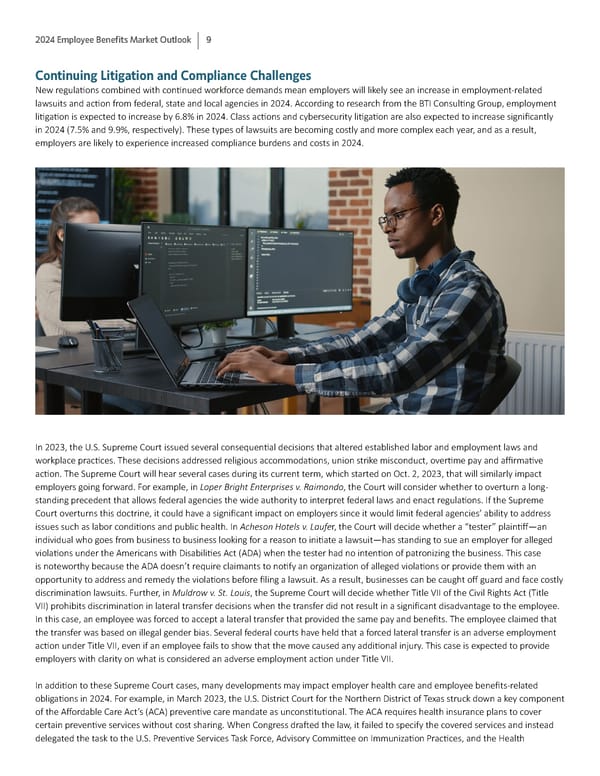2024 Employee Benefits Market Outlook 9 Continuing Litigation and Compliance Challenges New regula琀椀ons combined with con琀椀nued workforce demands mean employers will likely see an increase in employment-related lawsuits and ac琀椀on from federal, state and local agencies in 2024. According to research from the BTI Consul琀椀ng Group, employment li琀椀ga琀椀on is expected to increase by 6.8% in 2024. Class ac琀椀ons and cybersecurity li琀椀ga琀椀on are also expected to increase signi昀椀cantly in 2024 (7.5% and 9.9%, respec琀椀vely). These types of lawsuits are becoming costly and more complex each year, and as a result, employers are likely to experience increased compliance burdens and costs in 2024. In 2023, the U.S. Supreme Court issued several consequen琀椀al decisions that altered established labor and employment laws and workplace prac琀椀ces. These decisions addressed religious accommoda琀椀ons, union strike misconduct, over琀椀me pay and a昀케rma琀椀ve ac琀椀on. The Supreme Court will hear several cases during its current term, which started on Oct. 2, 2023, that will similarly impact employers going forward. For example, in Loper Bright Enterprises v. Raimondo, the Court will consider whether to overturn a long- standing precedent that allows federal agencies the wide authority to interpret federal laws and enact regula琀椀ons. If the Supreme Court overturns this doctrine, it could have a signi昀椀cant impact on employers since it would limit federal agencies’ ability to address issues such as labor condi琀椀ons and public health. In Acheson Hotels v. Laufer, the Court will decide whether a “tester” plain琀椀昀昀—an individual who goes from business to business looking for a reason to ini琀椀ate a lawsuit—has standing to sue an employer for alleged viola琀椀ons under the Americans with Disabili琀椀es Act (ADA) when the tester had no inten琀椀on of patronizing the business. This case is noteworthy because the ADA doesn’t require claimants to no琀椀fy an organiza琀椀on of alleged viola琀椀ons or provide them with an opportunity to address and remedy the viola琀椀ons before 昀椀ling a lawsuit. As a result, businesses can be caught o昀昀 guard and face costly discrimina琀椀on lawsuits. Further, in Muldrow v. St. Louis, the Supreme Court will decide whether Title VII of the Civil Rights Act (Title VII) prohibits discrimina琀椀on in lateral transfer decisions when the transfer did not result in a signi昀椀cant disadvantage to the employee. In this case, an employee was forced to accept a lateral transfer that provided the same pay and bene昀椀ts. The employee claimed that the transfer was based on illegal gender bias. Several federal courts have held that a forced lateral transfer is an adverse employment ac琀椀on under Title VII, even if an employee fails to show that the move caused any addi琀椀onal injury. This case is expected to provide employers with clarity on what is considered an adverse employment ac琀椀on under Title VII. In addi琀椀on to these Supreme Court cases, many developments may impact employer health care and employee bene昀椀ts-related obliga琀椀ons in 2024. For example, in March 2023, the U.S. District Court for the Northern District of Texas struck down a key component of the A昀昀ordable Care Act’s (ACA) preven琀椀ve care mandate as uncons琀椀tu琀椀onal. The ACA requires health insurance plans to cover certain preven琀椀ve services without cost sharing. When Congress dra昀琀ed the law, it failed to specify the covered services and instead delegated the task to the U.S. Preven琀椀ve Services Task Force, Advisory Commi琀琀ee on Immuniza琀椀on Prac琀椀ces, and the Health
 2024 Employee Benefits Market Outlook Page 8 Page 10
2024 Employee Benefits Market Outlook Page 8 Page 10